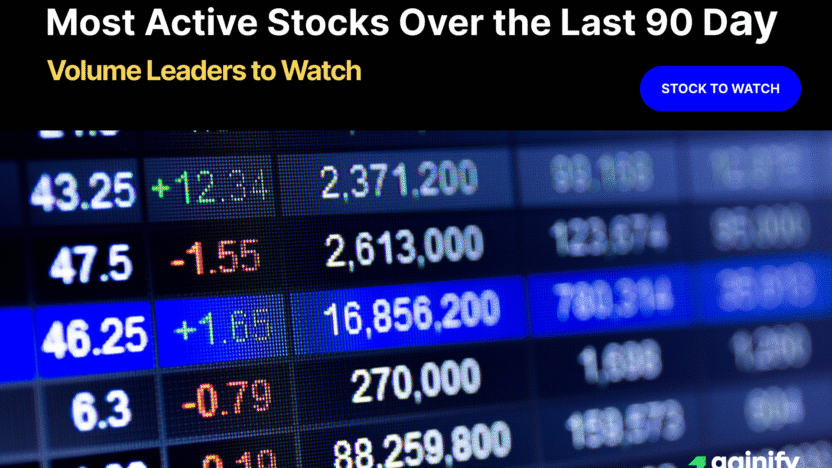Every trading session, certain companies dominate market activity. These are called the most active stocks, and they reflect where the largest amounts of capital are moving in the market. Knowing how to interpret this activity is important for both traders and long-term investors. This article explains how “most active” is measured, provides a ranking of today’s leaders, and explores what the data means for investment decisions.
How to Measure “Most Active” Stocks
When a stock is described as “most active,” it can refer to different types of activity. Investors should understand the key metrics:
- Average Trading Volume (90-day): Measures how many shares trade on an average day over the last 90 sessions. This smooths out daily noise and avoids overemphasizing unusual one-day spikes.
- Average Dollar Volume (90-day): The most meaningful metric. This multiplies a stock’s price by its 90-day average trading volume, showing how much actual money flows through the stock on an average day. Professional investors track this figure because it best reflects liquidity and real capital flow.
- Relative Volume vs. 90-day average: Compares today’s activity with the 90-day norm. A stock trading at three to five times its usual level often signals a major catalyst such as earnings, news, or institutional moves.
👉 Example: Intel (INTC) has a 90-day average volume of about 110 million shares at $37 per share, which equals roughly $2.75 billion in average daily dollar volume. Tesla (TSLA) has a lower 90-day average share count at 98 million, but at $430 per share its average daily dollar volume is nearly $34 billion. This shows why average dollar volume over 90 days is the best measure of market impact.
Today’s Most Active Stocks by Dollar Volume
Here are the top 16 most active stocks, ranked by their average daily dollar volume (price × 90-day average volume).
# | Symbol | Company | Price | 90D Avg Volume | $ Volume (90D Avg) |
1 | Tesla, Inc. | $429.83 | 98.22M | $33.86B | |
2 | NVIDIA Corp. | $187.62 | 181.94M | $30.17B | |
3 | Apple Inc. | $258.02 | 55.25M | $12.19B | |
4 | Palantir Tech. | $173.07 | 71.82M | $11B | |
5 | Microsoft Corp. | $517.35 | 20.02M | $10.07B | |
6 | $219.51 | 42.37M | $9.42B | ||
7 | $710.56 | 11.88M | $8.67B | ||
8 | $164.67 | 52.4M | $8.09B | ||
9 | Broadcom Inc. | $338.37 | 22.78M | $6.76B | |
10 | Alphabet Inc. | $246.45 | 24.66M | $4.95B | |
11 | Oracle Corp. | $286.14 | 18.95M | $4.89B | |
12 | Robinhood Markets | $148.67 | 44.84M | $4.6B | |
13 | $839.87 | 4.24M | $3.13B | ||
14 | $187.83 | 23.25M | $3.02B | ||
15 | Intel Corp. | $36.83 | 110.05M | $2.75B | |
16 | $40.06 | 54.22M | $1.05B |
Key Themes in the Most Active Stocks
The list of most active stocks is not random. It reflects clear themes that dominate the market:
- Tech mega-caps dominate liquidity. Tesla, Apple, Microsoft, Amazon, Meta, and Alphabet consistently appear at the top. These names act as anchors of market activity because of their massive size, constant institutional trading, and presence in nearly every ETF or index.
- AI and semiconductors are at the center of flows. NVIDIA, AMD, Broadcom, Micron, and Intel highlight the surge of capital into artificial intelligence, data centers, and semiconductor supply chains. These stocks move billions daily as investors look for exposure to the AI revolution.
- Healthcare is gaining attention. Eli Lilly is the standout non-tech company. Demand for its obesity and diabetes treatments has made it one of the most valuable pharmaceutical stocks in the world and a consistent presence on the active list.
- Speculative and retail favorites stay in play. Palantir and Robinhood often appear due to retail enthusiasm, contracts tied to artificial intelligence, and exposure to crypto markets. Rigetti also joins as a speculative quantum computing play with unusually high trading activity relative to its size.
Why Investors Track Most Active Stocks
Tracking the most active stocks is more than a curiosity. It offers practical insights for investors and traders:
- Liquidity advantage. Highly active stocks are easier to buy and sell in large size without moving the price too much. This is why institutions prefer them.
- Market sentiment. The active list is a real-time snapshot of what sectors and companies have investor attention. For example, when semiconductor names dominate, it signals a clear trend in capital allocation.
- Catalyst identification. Sudden jumps in dollar volume often signal earnings surprises, regulatory approvals, analyst upgrades, or other market-moving events. Watching this list helps investors spot these catalysts quickly.
- Volatility awareness. High activity is not always a positive sign. It can reflect speculative trading or excessive volatility. Differentiating between stable activity in companies like Microsoft and speculative flows in smaller firms is essential.
Investor Takeaways
- Dollar volume matters most. It provides a truer measure of market activity compared with share count.
- Volume spikes are signals. Stocks that trade three to five times their normal volume usually have important news or developments driving the move.
- Separate speculation from stability. Mega-cap technology names provide consistent liquidity, while stocks like Palantir, Robinhood, or Rigetti often trade more on hype and volatility than fundamentals.
- Use the list as a tool, not a strategy. The most active list should be seen as a market barometer that highlights where money is flowing. It should not be used as a direct buy list without further research.




